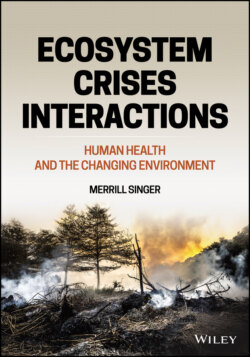Читать книгу Ecosystem Crises Interactions - Merrill Singer - Страница 16
1.3.2 One Health
ОглавлениеDevelopment of the One Health approach was motivated at official levels (e.g., the World Health Organization, WHO; the U.N. Food and Agriculture Organization, FAO; the World Organisation for Animal Health, OIE) by recognition that many of the same microbes infect both animals and humans. Diseases like COVID‐19 that have passed from nonhuman animal to human populations are known as zoonotic diseases. Almost two‐thirds of human pathogens have a zoonotic origin, and almost three‐quarters of emerging and re‐emerging infectious diseases of humans are zoonoses (Woolhouse & Gowtage‐Sequeria 2005). These include both newer human threats, such as COVID‐19, severe acute respiratory syndrome (SARS), West Nile virus, Nipah virus, and bovine spongiform encephalopathy (BSE), and ancient zoonotic maladies, such as rabies, anthrax, brucellosis, bovine tuberculosis, and zoonotic trypanosomiasis. The incidence of both types has risen significantly over time, contributing to a significant contemporary burden on global public health (Morens et al. 2004). Moreover, their occurrence is significantly correlated with identifiable socioeconomic, environmental, and ecological factors, especially social inequality, environmental and habitat degradation, and ecosystem disruption. In the case of the emergence of COVID‐19 as a human disease, for example, there is growing evidence indicating the role of deforestation and land use for intensive farming in the pandemic (Arora & Misra 2020). Many of these multihost dangers require multisectoral responses, as efforts by just one sector (e.g., biomedicine or veterinary medicine) cannot prevent or eliminate the problem. In the case of rabies in humans, for example, targeting of the animal source of the virus (e.g., vaccinating dogs) is required to control incidence (Lloyd‐Smith et al. 2009). At any point in time, particular zoonotic threats may be wide‐ranging (e.g., the influenzas globally), regional (e.g., Middle East respiratory syndrome, MERS), or local (e.g., Kyasanur forest disease in parts of India). Different forms of monitoring at the human–animal interface are required depending on the conditions and route of transmission. Moreover, local and regional zoonotics may spread widely beyond their point of origin. While found primarily in Middle Eastern countries, for example, confirmed cases of MERS have been identified in Austria, China, France, Germany, Greece, Italy, Malaysia, the Netherlands, the Philippines, the Republic of Korea, Thailand, the United Kingdom, and the United States (CDC 2017). In the case of COVID‐19, spread has included all nations. All disease vectors (e.g., mice, deer) and pathogenic diseases have their own features, and thus there is no single surveillance, prevention, or intervention strategy to tackle all zoonotic threats to health. One Health stresses expanding awareness of the conscious and less overt ways in which humans interact with animals in their daily lives (e.g., livestock for food, pets, hunting) (see Fig. 1.1). While animals represent part of the human physical environment, they also are deeply embedded in the human social environment. Increasing movements of people and an increased trade in animals and animal products are contributing to emerging zoonoses.
Fig. 1.1 Zoonotic disease triad.
The Washington, D.C.‐based One Health Commission defines One Health as “the collaborative effort of multiple health science professions, together with their related disciplines, and institutions—working locally, nationally, and globally—to attain optimal health for people, domestic animals, wildlife, plants, and our environment” (Roger et al. 2016). An outgrowth of collaboration between the American Veterinary Medical Association (AVMA) and the American Medical Association (AMA), and ultimately the American Public Health Association (APHA) as well, the One Health Commission seeks to break down disciplinary silos and establish closer professional interactions, collaborations, and educational and research opportunities across the health science professions. Alternatively, the One Health approach has been defined by the One Health Global Network—a worldwide computer‐linked assemblage of organizations (e.g., One Health Alliance of South Asia, One Health Central and Eastern African Network, International Federation of Red Cross and Red Crescent Societies, Centers for Disease Control and Prevention One Health)—as an effort to “improve health and well‐being through the prevention of risks and the mitigation of effects of crises that originate at the interface between humans, animals, and their various environments” (Whitmee et al. 2015). In both of these definitions, focus is placed on a “whole of society” orientation in which all of the health sciences work collaboratively across traditionally well‐guarded disciplinary borders not only to improve the health of humans and animals but also to address biodiversity, ecology disruption, climate change, urbanization, and the changing impacts of expanding agricultural systems.
In Lerner & Berg’s (2017) assessment, the core values of One Health involve safeguarding the health—and especially the individual health—of vertebrate species. There have been calls to expand the One Health concept. Keune et al. (2017) identify ecology, agriculture, and especially the social sciences as missing links for a coherent One Health approach. From their perspective, “[s]ocial and cultural drivers of health are often neglected and considered only in case of programme failure” (Kene et al. 2017, pp. 7–8).
